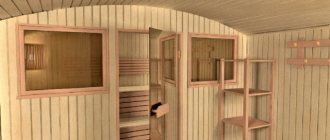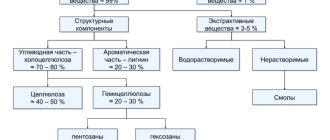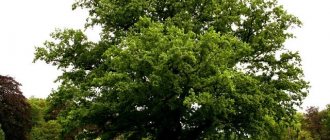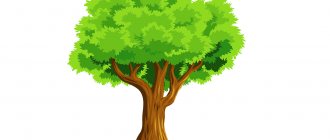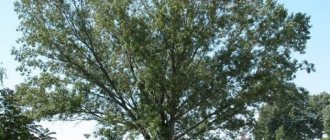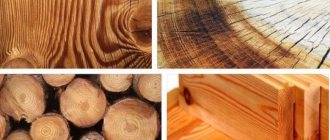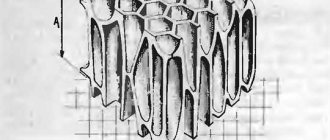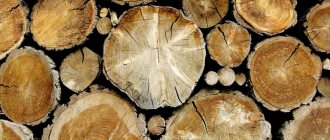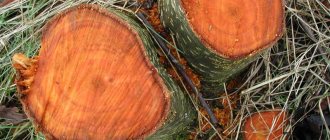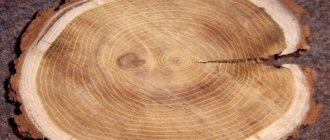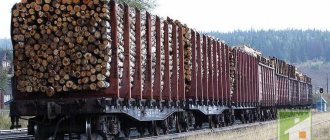In this article:
- Practical benefits of a walk in the forest
- Defects in the shape of the barrel
- Wood structural defects
The quality of lumber depends not only on the size and type of wood, the manufacturer’s compliance with all the subtleties of the technological process, but also on the conditions of its growth. Wood has many types of subtle developmental defects and consequences of mechanical damage, most of which are practically invisible from the outside (to the untrained eye, of course).
Any defect complicates processing and weakens the strength qualities of wood and products made from it. So what are the types of wood defects and how to recognize them in time?
Types of wood
Wood is a universal material that can be easily processed and used in various fields of production: construction, furniture, dishes and other household items. The scope of application depends on the type of wood with different physical, chemical and mechanical properties. In construction, coniferous species such as spruce, cedar, pine, larch, and fir are especially popular. To a lesser extent, deciduous trees - birch, poplar, aspen, oak, hazel, linden, alder, beech.
You may be interested in: A sensitive question - what is it?
Coniferous varieties are used in the form of round timber, timber, boards for the manufacture of support piles, trusses, pillars, bridges, houses, arches, industrial facilities, as well as other building structures. Hardwood materials account for only a quarter of total consumption. This is due to the worse physical and mechanical properties of deciduous timber, so they are trying to use them for the manufacture of structures with low load-bearing loads. Usually they go to draft and temporary object nodes.
The use of timber in construction is regulated by rules in accordance with the physical and mechanical properties of wood. These properties depend on humidity and the presence of defects. For load-bearing elements, humidity should not exceed 25%; for other products there are no such requirements, but there are standards for specific wood defects.
Wood materials used to build a house
Before choosing a material, take into account its price, shrinkage rate and durability of the tree. After processing, the wood comes in the form of lumber - logs, beams, carriages, boards. Handmade materials are expensive.
Wood:
- Logs that have undergone mechanical processing are more durable, because the protective layer under the bark is not removed from them. Working with lumber is more difficult; they do not always have even geometric proportions.
- The rounded log has a regular geometric shape. 2-4 layers of wood are removed from logs, thereby weakening its protective properties.
- Calibrated logs are made with the same diameter of at least 250 mm. If it is smaller, the building will have to be insulated.
- Solid timber - the material is made from the core of a tree, has a square or rectangular cross-section.
- Glued laminated timber - consists of boards glued together under pressure. The material is not deformable, does not break, does not crack. The lumber has a wide cross-section, so there is no need to additionally insulate the house.
- Carriage is a material similar to timber and logs. The wood is cut off from the sides to create a log with planes on the sides.
Often, when building a house, boards are used. It has a standard size of up to 6 m, thickness up to 10 cm. Before choosing boards for building a house, you need to inspect them. They should not be bent, crooked, twisted or cracked. Boards are used in the manufacture of beams, frame floors, for cladding inside the building, for flooring and finishing.
Chemical composition
You may be interested in: Units of measurement of engine torque
99% of the wood mass contains organic matter. The composition of elementary particles is the same for all rocks: nitrogen, oxygen, carbon and hydrogen. They form long chains of more complex molecules. Wood consists of:
- Cellulose is a natural polymer with a high degree of polymerization of chain molecules. A very stable substance, insoluble in water, alcohol, or ether.
- Lignin is an aromatic polymer with a complex molecular structure. Contains a large amount of carbon. Thanks to it, lignification of tree trunks appears.
- Hemicelluloses are an analogue of ordinary cellulose, but with a lower degree of polymerization of chain molecules.
- Extractive substances - resins, gums, fats and pectins.
The high content of resins in coniferous trees preserves the material and allows it to maintain its original properties for a long time, helping to resist external influences. Low-grade timber with a large number of defects is used mainly in the wood chemical industry as raw material for the production of paper, laminated wood or the extraction of chemical elements such as tannins used in leather production.
Appearance
Wood has the following external properties:
- Color. Visual perception of the reflected spectral composition of light. Important when choosing sawlogs as a finishing material.
- The color depends on the age and type of tree, as well as the climatic conditions where it grew.
- Shine. Ability to reflect light. The highest rates are observed in oak, ash, and acacia.
- Texture. The pattern formed by the growth rings of the trunk.
- Microstructure. Determined by the width of the rings and the content of late wood.
You may be interested in: A brief history of pedagogy: stages of development, meaning and goals
The indicators are used for external assessment of the quality of logging. Visual inspection allows you to identify defects and the suitability of materials for subsequent use.
Where are different types of wood used?
Lumber products in one form or another are widely used in various fields. For example, first-grade materials are actively used in the construction of ships and other vessels.
It also has a certain degree of use in aviation. In addition, this is an excellent basis for veneer, which ultimately, after special processing, will have high quality indicators.
Second-grade lumber has found its use in the construction of barges, in the mechanical engineering and construction industries. Third grade wood is used as railway sleepers and special beams to meet the needs of the railway. Also, this kind of materials is widely used in the furniture industry.
Forest Fund of Russia | Lumber | Prices for it
stroika-uslugi.ru›Lesnoj-fond…Pilomaterial.htm Such areas of the forest fund determine the production of edged lumber… Read more
As for the use of wood of the lowest grades, the simplest example of its use can be called the production of furniture products and special industrial containers. The costs are low and the products end up being relatively inexpensive.
Wood defects
Despite the obvious advantages over synthesized materials, wood, like any natural raw material, has its disadvantages. The presence, extent and area of damage is regulated by regulatory documents. The main wood defects include:
- damage, rot, fungi and pests;
- cross-bed;
- resin pockets;
- knots;
- cracks.
Knotiness reduces the strength of timber; their quantity, size and location are of particular importance. Knots are divided into types:
- Healthy. They grow tightly together with the body of the tree and sit firmly in pockets, without rot.
- Drop-downs. They peel off and fall off after sawing the material.
- Horny. Dark in color and have a denser structure in relation to neighboring wood;
- Darkened. Knots with the initial stage of rotting.
- Loose - rotten.
Based on their location, knots are divided into:
- stitched;
- palmate;
- overgrown;
- stepsons.
Cross-layering also reduces the bending strength of wood and is characterized by the presence of cracks and spiral layers in round timber; in sawn material they are directed at an angle to the ribs. Products with such a defect are considered low-grade and are used exclusively as temporary reinforcements.
The causes of cracks depend on external conditions and the type of wood. They are formed as a result of uneven drying, frost, mechanical stress and many other factors. They appear both on living trees and on cut ones. Depending on the position on the trunk and shape, cracks are called:
- frost-killing;
- sernitsa;
- metics;
- shrinkage.
Cracks not only reduce the quality of the wood, but also contribute to rapid rotting and destruction of the fibers.
Rot is formed due to infection by putrefactive and other types of fungi that appear on growing and cut trees. Fungi that live on living trunks are parasitic, affecting annual rings and causing them to peel off. Other species settle on finished structures and cause rotting, delamination, and cracking.
The reason for the appearance of harmful organisms is a favorable environment for their reproduction: humidity above 50% and warmth. Microorganisms do not develop on well-dried timber. A special category of pests includes insects that prefer to settle in wooden structures, making passages in them, thereby damaging the fibers and reducing their strength.
Practical benefits of a walk in the forest
Professionals know how wood defects manifest themselves and are able to assess its quality using an individual inventory method even before cutting a tree. Such an assessment is needed for preliminary calculations on the following issues:
- what will be the yield of quality raw materials;
- at what height the trunk will be sawn into separate parts;
- sizes of individual cuts, their practical application, etc.
For example: a taxed pine trunk with a diameter of 28 cm at a height of 1 m from the ground has butt rot. At a height of 1-7.5 m there are no branches on the trunk, and the wood looks healthy. At a height of 9.5 m there is a pine sponge (fungal infection), from which stem rot spreads 0.5 m up and 1.5 m down the trunk. In the distance from 9.5 m to 15.5 m there are only dead outer branches, and the wood itself looks healthy.
Taxation results:
- a meter-long butt layer is used for firewood;
- 6.5 m – first-class sawlog;
- 2m – re-grade (it is unknown how deep the rot is);
- the last 6m can be used as an ore stand.
Wood moisture content
One of the important indicators for the standard and calculated resistance of wood. It affects the percentage of water in the fibers of the trunk. Humidity is the percentage of moisture mass to dry material. The calculation formula looks like this: W = (m–m0)/m0 * 100, where m is the initial mass of the workpiece, m0 is the mass of the absolute dry sample. Humidity is determined in two ways: by drying and using special electronic moisture meters.
Based on moisture content, wood is divided into several types:
- Wet. With a moisture content of more than 100%, which corresponds to a long stay in water.
- Freshly sawn. With content from 50 to 100%.
- Air dry. With fiber water content ranging from 15 to 20%.
- Room-dry. With moisture content from 8 to 12%.
- Absolutely dry. With 0% water content, obtained by drying at a temperature of 102°.
You will be interested in: What are “seeds”, where did they come from and where are they used?
Water is found in wood in bound and free form. Free moisture is found in cells and intercellular space, bound moisture is in the form of chemical bonds.
The influence of moisture on the properties of wood
There are several types of properties depending on the moisture content in the wood structure:
- Shrinkage is a reduction in the volume of wood pulp fibers when bound water is removed from them. The more fibers, the more moisture of the bound type. Removing moisture does not have this effect.
- Warping is a change in the shape of timber during the drying process. Occurs when logs are improperly dried or sawed.
- Moisture absorption is the hygroscopicity of wood or the ability to absorb moisture from the environment.
- Swelling is an increase in the volume of wood fibers when the material is in a humid environment.
- Water absorption is the ability of wood to increase its own moisture content by absorbing droplets of liquid.
- Density - measured as mass per unit volume. As humidity increases, density increases, and vice versa.
- Permeability is the ability to allow water to pass through under high pressure.
After drying, the wood loses its natural elasticity and becomes harder.
Alternative fuel materials
The calorific value of certain types of firewood is quite high, but far from the maximum possible. In order to save money and space for storing heating material, today more and more attention is being paid to alternative options. It is optimal to use pressed briquettes.
The efficiency of using briquettes is several times higher than that of firewood
For the same oven load, pressed wood produces much more heat. This effect is possible by increasing the density of the material. In addition, there is a much lower percentage of humidity. Another plus is minimal ash formation.
Briquettes and pellets are made from sawdust and wood chips. By pressing waste, it is possible to create an incredibly dense combustion material that even the best types of wood cannot compare with. With a higher cost per cubic meter of briquettes, the final savings can amount to a very significant amount.
It is necessary to prepare and purchase combustion materials based on a thorough analysis of their properties. Only high-quality firewood can provide you with the necessary heat without causing harm to your health or the heating structure itself.
Hardness
The hardness coefficient is determined using the Brinell method or the Yankee test. Their fundamental difference lies in the measurement technique. According to Brinell, a hardened steel ball is placed on a flat wooden surface and 100 kilograms of force are applied to it, after which the depth of the resulting hole is measured.
The Yankee test uses a ball with a diameter of 0.4 inches and measures how much force, in pounds, it takes to push the ball half its diameter into the wood. Accordingly, the higher the result obtained, the harder the wood and the higher the coefficient. However, within one variety the indicators differ, depending on the cutting method, humidity and other factors.
Below is a table of wood hardness according to Brinell and Yankee for the most common species.
| Name | Brinell hardness, kg/mm2 | Yankee hardness, lbs. |
| Acacia | 7,1 | |
| Birch | 3 | 1260 |
| Karelian birch | 3,5 | 1800 |
| Elm | 3 | 1350 |
| Pear | 4,2 | |
| Oak | 3,7-3,9 | 1360 |
| Spruce | 660 | |
| Linden | 400 | |
| Larch | 2,5 | 1200 |
| Alder | 3 | 590 |
| European walnut | 5 | |
| Spanish walnut | 3,5 | |
| Aspen | 420 | |
| Fir | 350-500 | |
| Rowan | 830 | |
| Pine | 2,5 | 380-1240 |
| Cherries | 3,5 | |
| Apple tree | 1730 | |
| Ash | 4-4,1 | 1320 |
From the wood hardness table it can be seen that:
- aspen, spruce, fir, pine are very soft trees;
- birch, linden, alder and larch are soft species;
- elm and walnut are medium hard;
- oak, apple, cherry, ash, pear and have a coefficient of normal hardness;
- beech, acacia and yew are very hard varieties.
Solid wood is resistant to mechanical stress and is used for critical components of wooden structures.
Material selection
Even the highest qualities of wood can be negated if it is chosen incorrectly for a specific type of activity. For example, it practically doesn’t matter what was used for the night fire when gathering with friends. Lighting a fireplace or stove in a bathhouse is a completely different matter.
We recommend reading the material on where to store firewood in addition to this article.
For each situation, materials of different thickness, type and properties are selected
For the fireplace
Heating your home can become a problem if you load your stove with the wrong wood. This is especially dangerous when using a fireplace, since a sparkling log can even lead to a fire.
The unobtrusive burning of wood and the heat emanating from the fireplace are the highlight of the living room
For long burning and the release of a large amount of heat, you should give preference to oak, acacia, as well as birch and walnut. To clean the chimney, you can burn aspen and alder from time to time. The density of these rocks is small, but they have the ability to burn soot.
For the bath
To ensure a high temperature in the steam room of the bathhouse, maximum heat transfer from the firewood is required. In addition, you can improve your relaxation conditions if you use breeds that saturate the room with a pleasant smell, without emitting harmful substances and resins.
About
Density
Density directly depends on the moisture content of the fibers. Therefore, to obtain uniform measurement indicators, it is dried to a level of 12%. Increasing the density of wood leads to an increase in its mass and strength. Based on moisture content, timber is divided into several groups:
- Rocks with the lowest density (up to 510 kg/m3). These include fir, pine, spruce, poplar, cedar, willow and walnut.
- Rocks with medium density (in the range of 540-750 kg/m3). These include larch, yew, elm, birch, beech, pear, oak, ash, rowan, and apple.
- Rocks with high density (more than 750 kg/m3). This category includes birch and stock.
Below is a table of densities for different tree species.
| Breed name | Rock density, kg/m3 |
| Acacia | 830 |
| Birch | 540-700 |
| Karelian birch | 640-800 |
| Beech | 650-700 |
| Cherry | 490-670 |
| Elm | 670-710 |
| Pear | 690-800 |
| Oak | 600-930 |
| Spruce | 400-500 |
| Willow | 460 |
| Cedar | 580-770 |
| European maple | 530-650 |
| Canadian maple | 530-720 |
| field maple | 670 |
| Larch | 950-1020 |
| Alder | 380-640 |
| Walnut | 500-650 |
| Aspen | 360-560 |
| Fir | 350-450 |
| Rowan | 700-810 |
| Lilac | 800 |
| Plum | 800 |
| Pine | 400-500 |
| Poplar | 400-500 |
| Thuja | 340-390 |
| Bird cherry | 580-740 |
| Cherries | 630 |
| Apple tree | 690-720 |
Coniferous species have the lowest density, while deciduous species have the highest.
Cedar (Siberian) pine
When using the term “cedar” there is almost always inaccuracy. On the territory of Russia, the biological genus Cedar (Cedrus) grows locally only in Crimea. The tree has a spreading crown, not a ship trunk at all, and it does not have pine cones as we understand them (the cones are small and inedible for humans). And what is commonly considered cedar is actually Siberian pine, a different biological genus.
Siberian pine (cedar) pine wood is a leader in all respects except price. Cedar pine wood is a leader in plasticity, it is soft, easy to process, but at the same time durable. High resistance to rotting, not susceptible to insect infestation. The wood deforms little, there are much fewer cracks on it than in pine, and it is resistant to changes in temperature and humidity. Cedar pine has low thermal conductivity and excellent thermal insulation properties. A cedar house provides a healthy microclimate: cedar pine is a natural antiseptic.
Volumetric weight at a humidity of 12% is about 580 kg/m3 - the wood is lighter than larch, comparable to or slightly heavier than pine.
The only significant drawback of cedar is its high cost.
Stability
The calculated resistance of wood includes such a thing as resistance to moisture. The degree is measured on a five-point scale when air humidity changes:
- Instability. Significant deformation appears even with a slight change in humidity.
- Average stability. A noticeable degree of deformation appears with a slight change in humidity.
- Relative stability. A slight degree of deformation appears with a slight change in humidity.
- Stability. There is no visible deformation with slight changes in humidity.
- Absolute stability. There is absolutely no deformation even with large changes in humidity.
Below is a table of the stability of common wood species.
| Breed name | Degree of stability |
| Acacia | 2 |
| Birch | 3 |
| Karelian birch | 3 |
| Beech | 1 |
| Cherry | 4 |
| Elm | 2 |
| Pear | 2 |
| Oak | 4 |
| Spruce | 2 |
| Cedar | 4 |
| European maple | 2 |
| Canadian maple | 2 |
| Field maple | 1 |
| Larch | 2-3 |
| Alder | 1 |
| American walnut | 4 |
| Brazil nut | 2 |
| Walnut | 4 |
| European walnut | 4 |
| Spanish walnut | 3 |
| Aspen | 1 |
| Fir | 2 |
| Poplar | 1 |
| Bird cherry | 1 |
| Cherries | 2 |
| Apple tree | 2 |
Indicators are calculated for wood with a moisture content of 12%.
Mechanical characteristics
The quality of wood is determined by the following indicators:
You may be interested in: Sterlitamak Polytechnic College: address, specialties, admission conditions
Constant loads gradually deteriorate the properties of wood and lead to fatigue of the material. Even the strongest tree is not able to withstand external influences.
Which wood is better to choose for building a house?
Wood for a home is chosen based on the difference in materials and tree species. Pine species are often used. Spruce and pine are similar in their properties; spruce wood is looser than pine, but it retains heat better. Larch is valued for its characteristics. This material is more durable compared to pine. Wood does not rot even in water. The rock's high fire resistance and durability are noted. A log house made of cedar and larch will stand without repair for at least half a century.
Among deciduous species, oak should be noted, which has no disadvantages and is durable in use. This type of wood is resistant to moisture and is superior in strength to all other types.
Regulatory characteristics
Standard resistance indicators are necessary for the manufacture of various types of structures. Wood is considered suitable if the indicators are not lower than the calculated values. In tests, only standard samples with a moisture content not exceeding 15% are used. For wood with a different moisture content, a special formula for calculated resistance is used, then the indicators are converted to standard values.
When designing wooden structures, it is important to know the actual strength values of the source material. In reality, they are less than the normative values obtained on test samples. Reference data are obtained by loading and deforming samples of standard sizes.
Design characteristics
The design resistance of wood is the stresses in different planes of wooden samples created by certain loads that the tree can withstand for any amount of time before complete destruction. These indicators differ for stretching, compression, bending, chipping and crushing.
Actual indicators are obtained by multiplying standard data by operating condition coefficients.
| Name | Wood design resistance coefficient | ||
| Tension along the fibers | Tension across the fibers | Chipping | |
| Larch | 1,2 | 1,2 | 1 |
| Siberian cedar | 0,9 | 0,9 | 0,9 |
| Pine | 0,65 | 0,65 | 0,65 |
| Fir | 0,8 | 0,8 | 0,8 |
| Oak | 1,3 | 2 | 1,3 |
| Maple, ash | 1,3 | 2 | 1,6 |
| Acacia | 1,5 | 2,2 | 1,8 |
| Beech, birch | 1,1 | 1,6 | 1,3 |
| Elm | 1 | 1,6 | 1 |
| Poplar, alder, aspen, linden | 0,8 | 1 | 0,8 |
Working conditions are influenced by a whole list of factors. The above ratios take such factors into account. Any exposure to moisture on structures leads to a decrease in final performance.
